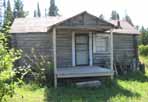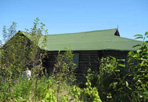
Sam Johnson/Ed Holte
Wright Island
By: Toupal, Stoffie, and Zedeno

Holte Residence, 1950s: [NVIC: 50-1124], ISRO Archives.
ocated in the north end of Siskiwit Bay, Wright's Island, known also as the Holte Fishery, has two harbors. The northern harbor, however, offers much less protection than the south harbor, which was home to Sam Johnson's family and to the Holte family. The fish camp remained in the Johnson family, in a manner of speaking, since Sam's daughter Ingeborg married Ed Holte and they maintained the fishery.
The core of the Wright's Island fishery begins with the main fish camp and extends to the harbor, the edge of the woods, and the south point of the island. It goes on to include the entire island, the waters to Schooner Island on the northeast, the waters to Little Siskiwit Island on the southwest, to the main shore of Isle Royale, and to the archipelago of Long, Menagerie, and Paul Islands in the southeast.
The site represents one of the traditional fisheries of the Island that has continued since prehistoric times. A fish company, that processed fat trout, or siskowit, for oil, was located here at the turn of the century. Remnant oily sand and Indian artifacts of pottery, needles, and bone found along the beach, indicate a long history of use of the site. Indications of logging and mining, however, have not been found. In addition to living and fishing, use of the site included hunting, gathering food, and celebrations.
Sam Johnson and Ed Holte are the best remembered fishermen of Wright's Island but others who occupied the site before them include the Ronnings (John and Fina) and the Purdys (Charles Freeman and Mary). Through family relations, Wright's Island is connected to Chippewa Harbor. Social and fishing relationships connect it to Cheringa (Old Lady's Point), Shiverette Island, Hay Bay, and Fisherman's Home. The fishing grounds associated with Wright's Island were contiguous to those of the Hay Bay and Fisherman's Home folks, the Skadbergs and Rudes respectively.
Physical Description
National Park Service
The Holte Fishery has been described as equal to the Edisen Fishery in its representation of a Scandinavian-American fishery operation during the prime fishing years, the 1920s, on Isle Royale. The Holte, Anderson, and Andrew/Scotland camps contain the only log structures built specifically for commercial fishing use in the park. Other log structures exist, but they were not constructed for commercial fishing purposes. A number of the fishermen built log structures, but few remain. The Holte Main Residence is significant as a representative example of log fishery structures.
The fishery buildings are a combination of old buildings, additions and recycled buildings. The present Holte residence is approximately 80 feet from the shoreline in the center of the fishery. It was built by Steve Johnson in the mid-1920s for him and his wife in which to live. The elder Sam Johnson leased the island from the Merritts of Rock Harbor. He moved into the house with his son and daughter-in-law, which was partitioned into three rooms separated by curtains.
This dwelling was remodeled twice, first in the late 1920s adding a wing perpendicular to the original building, and again in the early 1930s, adding a shed-roofed addition at the rear of the wing. The current plan of the house is a t-plan. The front porch was added in 1935 by Ed Holte. The pitched-roofed one-story dwelling, wing, and front porch are all constructed of saddle notched logs rather than milled lumber which is typical of first generation Swedish-American construction on Isle Royale. The shed-roofed rear room is nailed. The roofs have pole rafters and are covered with tarpaper. There is also tarpaper skirting. Four and six light windows exist in various locations.
Image Gallery
Site Map: Early Era

Holte Fishery Site Map, Early Era: Tim Cochrane (1983), Isle Royale National Park.
Site Map: Late Era

Holte Fishery Site Map, Late Era: Tim Cochrane (1983), Isle Royale National Park.
Help Tell The Story
Are you related to this family? Would you be willing to share stories or photos associated with related events? If so, we would love to hear from you! Please contact the Cultural Resource Manager at Isle Royale National Park. Or write to:

800 East Lakeshore Drive
Houghton, Michigan 49931-1896
906-482-0984
Citations
- National Park Service Cultural Landscapes Inventory. 2010. Holte Fishery. Park Historic Architecture and Cultural Landscapes Program, U.S. National Park Service.
- Toupal, Rebecca S., Richard W. Stoffie, and M. Nieves Zedeno. The Isle Royale Folkefiskerisamfunn: Familier som levde av fiske: An Ethnohistory of the Scandinavian Folk Fishermen of Isle Royale National Park. Report for the National Park Service, Midwest Regional Office. Tucson: Bureau of Applied Research in Anthropology, University of Arizona, 2002.
![Old Net House on Wright Island, 1950s: Hakala [NVIC: 50-762], ISRO Archives.](../../Siskiwit_Bay/Holte/Jpegs/Small/NVIC-50-762.jpg)
![Holte Fish House (#208), 1950s: [NVIC: 50-1120], ISRO Archives.](../../Siskiwit_Bay/Holte/Jpegs/Small/NVIC-50-1120.jpg)
![Holte Fish House (#209), 1950s: [NVIC: 50-1121], ISRO Archives.](../../Siskiwit_Bay/Holte/Jpegs/Small/NVIC-50-1121.jpg)
![Holte Net House (#210), 1950s: [NVIC: 50-1122], ISRO Archives.](../../Siskiwit_Bay/Holte/Jpegs/Small/NVIC-50-1122.jpg)
![Holte Guest House (#211), 1950s: [NVIC: 50-1123], ISRO Archives.](../../Siskiwit_Bay/Holte/Jpegs/Small/NVIC-50-1123.jpg)
![Holte Residence (#212), 1950s: [NVIC: 50-1124], ISRO Archives.](../../Siskiwit_Bay/Holte/Jpegs/Small/NVIC-50-1124.jpg)
![Wright Island Fishery, 1950s: [NVIC: 50-1125], ISRO Archives.](../../Siskiwit_Bay/Holte/Jpegs/Small/NVIC-50-1125.jpg)
![Holte Dock (#212A), 1950s: [NVIC: 50-1126], ISRO Archives.](../../Siskiwit_Bay/Holte/Jpegs/Small/NVIC-50-1126.jpg)















